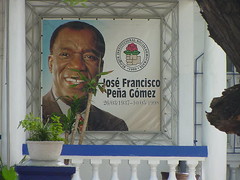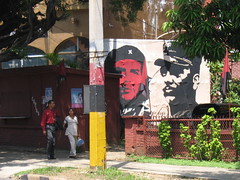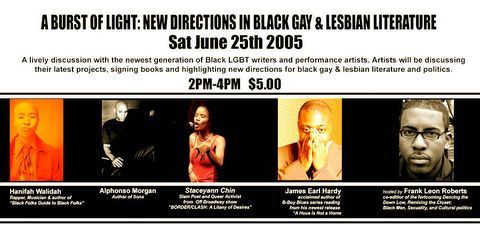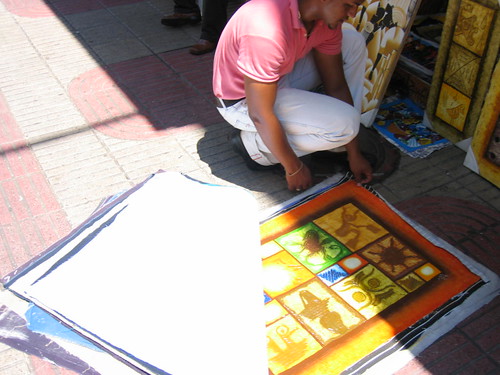
A truly momentous event has occurred just north of the upper tier of "blue states," which is to say, the U.S. border:
Canada's legislature, by a vote of
158-133, has ratified the 2004 decision of its Supreme Court that gay marriage legislation would not violate the country's constitution, making our sister nation and largest trading partner
only the third country in the world (after the two constitutional monarchies of the Netherlands and Belgium)
to legalize same-sex marriages. Liberal Party leader and Roman Catholic
Prime Minister Paul Martin, whose brief tenure at the head of the minority government has been marked by an ongoing financial scandal and a razor-thin win over his Conservative opposition just a few months ago, led the push for the legislation, which confirms what has been increasingly evident over the last few years, Canada's considerably more progressive stances on a range of social issues.
According to
Beth Duff-Brown's Yahoo! News/AP account, some of Martin's fellow Liberal lawmakers voted against the legislation and at least one Cabinet member resigned, but a coalition of various left-leaning parliamentarians--including members of the Bloc Québécois, who represent constituencies in what was once Canada's most conservative province but which is now one of its most socially liberal, and the reliably progressive New Democratic Party, which is part of the Liberals' governing coalition--provided enough votes to seal the win. The legislation is expected to pass in Canada's smaller, unelected, Liberal Party-dominated Senate, thereby becoming law at some point in July 2005.
Whatever one thinks of gay marriage or marriage in general as a social, political and economic institution--as a legal entity--the Canadian vote represents a landmark statement on behalf of equality, democracy and freedom. Many news accounts have noted that a majority of Canadians support the rights and freedom of gays and lesbians to marry, and so far 34,000 have done so. While the US Constitution's
14th Amendment, Section 1, final clause, passed in the wake of the North's resounding victory in the Civil War and the defeat of the nefarious slave system, clearly guarantees equal protection under all federal laws, the truth of the matter is in 49 states, the District of Columbia, and US territories LGBT people are obviously still being denied the equal protections and rights provided under our government's acknowledgement and certification of civil marriage. In Canada, although this was no longer the case in Ontario and British Columbia, two of its most populous provinces, as far back as 2003, the House of Commons decision comprehensively extends it by law to all the provinces, including the more conservative ones like Alberta.
Despite the fact that the US usually recognizes heterosexual/opposite-sex marriages contracted in most (all?) foreign countries, I would imagine that only Massachusetts will honor the Canadian same-sex marriages. (Will other nations, such as the more liberal ones in Europe, honor these marriages? How do they respond to unions civilly contracted in Belgium and the Netherlands?) That is, until other US states follow Massachusetts' lead. A judicial decision on same-sex marriage, I believe, is pending in New York State.
Addendum: Spain has just joined Canada in legalizing same-sex marriage. Despite vocal protests from the Roman Catholic Church and conservative politicians, Spain's Socialist Prime Minister José Luis Rodríguez Zapatero, who assumed control of the government after the popular uproar over the formerly right-wing government's inadequate response to the Madrid train bombings, was able to push the legislation through Spain's lower house of Parliament, the Congress of Deputies, by a vote of 187-147, overriding the country's Senate, which means that as in Canada, it will become law. (Doug Ireland quotes from Rodríguez Zapatero's remarkable speech, which in addition to making an impressive argument for equality and the notion of how interconnected everyone in Spanish society is, cites two of the greatest gay poets of all time, Luis Cernuda and Constantine Cavafy.)In fact, this is probably probably more earth-shaking than the Canadian vote, in part because Spain was for many years one of the most consistently conservative and Catholic of the major European countries. You could possibly chart this conservative period as running from Ferdinand and Isabela's unification of Spain and their expulsion or forced conversion of the Arabs and Jews in 1492, through the long period of the Holy Inquisition in the 16th and 17th centuries, to Francisco Franco's fascist rule, which lasted from 1939 through 1975, with a few interludes of liberalization. Since Franco's death and the restoration of the monarchy, Spain's government has alternated between the right and left, and in recent years, the former has consistently held power. In fact before the horrific train bombing on March 11, 2004, Spain had a right-wing governing coalition, headed by José Maria Aznar, which against the public will had sent Spanish soldiers to Iraq. With the ascension of the Socialists under Zapatero ("Shoemaker"), the country has witnessed a political sea-change that mirrors a longstanding change in social views, especially among the young. Zapatero promptly recalled the soldiers from Iraq and this week pushed through new divorce legislation and changes to stem-cell rules. Yahoo! News notes that such changes are "popular among young people," and that a poll last year showed that 70% of the population overall supported the move.‡‡‡
On a completely different note, I was planning to post an article I came across on DR1 by a young Black American woman who'd spent time in Santiago, the second largest city in the Dominican Republic, as part of an educational program and experienced a profound cultural--and in particular, racial--shock (Mendi and Keith Obadike's operatic piece
The Sour Thunder is based in part, I think, on Mendi's sojourn, while a student at Spelman, in Santiago); and I intended to post my own remarks, somewhat in response, on my experiences there. But it isn't happening just yet. Instead, I return to Mexico's problems with racism and racialist thinking, which have gotten some attention in recent months because of Mexican President Vicente Fox's comments on Mexicans immigrants' willingness to take jobs that "not even blacks" wanted, and because of what I describe below.
(Since I have mentioned the Dominican Republic, though, that country's inexactly parallel situation with Haitian workers--who are being forcibly repatriated as I type this, despite the incoherent Haitian government's attempts to close its borders, its appeals to the current Dominican administration's good will not to repatriate its people, the Dominican government's fear of appearing insensitive and racist, many Dominican patriots' desire to have the Haitians expelled and their fear of a "unification" of the two countries, and machinations of Dominican landowners and businesses to employ Haitians, who, given the devastation of their own country and their inability to freely immigrate to the US or Canada, take low-wage or slave-wage jobs in the DR--is worth broaching.)

Where am I going with all of this?
Memin Pinguin. Never heard of him? Neither had I. Well, he's a Mexican cartoon figure who is featured on a series of official government postage stamps being issued today. Nothing wrong with that, you say. Except that as shown at right, Memin Pinguin is a
racist grotesque, a homegrown Mexican Sambo-style coon depiction. And the racism of the Memin Pinguin depiction doesn't lie in the images alone; in the cartoon series in which he's featured since the 1940s, according to several accounts I've read, he embodies a number of the traditional, infantilizing racist stereotypes attributed to Black people in the US, particularly during the Jim Crow period (and exported all across the globe). Look out, Topsy!
But the Mexican government officials don't see there being anything wrong, of course. Their cartoon pickaninny is going to be an ambassador, "spreading good news," according to the publisher of the comics in which he appears! Ah yes, a racist and buffoonish drawing is going to serve as an international herald--
to whom? Fortunately, this "good news" wasn't lost on Black activists and others in Mexico, who condemned the Mexican government's decision to feature this overtly racist stereotypic depiction (along with the equally racist depiction of his
Mami/Mammy) on a series of national stamps. To quote the
CNN article:
The boy, hapless but lovable, is drawn with exaggerated features, thick lips and wide-open eyes. His appearance, speech and mannerisms are the subject of kidding by white characters in the comic book.
Activists said the stamp was offensive, though officials denied it.
"One would hope the Mexican government would be a little more careful and avoid continually opening wounds," said Sergio Penalosa, an activist in Mexico's small black community on the southern Pacific coast.
An official of the Mexican Postal Service couldn't help but reinforce the stereotype:
Carlos Caballero, assistant marketing director for the Mexican Postal Service, said the stamps are not offensive, nor were they intended to be.
"This is a traditional character that reflects part of Mexico's culture," Caballero said. "His mischievous nature is part of that character."
However, Penalosa said many Mexicans still assume all blacks are foreigners, despite the fact that at one point early in the Spanish colonial era, Africans outnumbered Spanish in Mexico.
Their own
little trickster bad chillun Other, and on stamps no less! I won't get into Mexico's complex and troubled racial history, which like every other nation in this hemisphere has included the marginalization and slaughter of Native peoples and the subsequent enslavement of Blacks (the two in particular were linked in Mexico's case because of Bartolomé de las Casas); one aspect of this history has been an enduring racism against its large indigenous Indian population, which has resulted in periodic flareups such as the war in Chiapas; a racism of a different but intense sort against its native Black population, which has long been presumed not to exist; and, among the White/European ruling élites, against the visibly mestizo majority, which is evident in Mexican-language media, politics, business circles, and so on. Related to these forms of racism is Mexico's guiding
mestizaje ideology, from which the Black "third root" has been almost completely erased and effaced in both official and popular discourse.

I will, however, broach the fact that when Lázaro Cárdenas (the son of Mexico's famous leftist leader Cuahtémoc Cárdenas, who was mayor of Mexico City and had the presidency stolen from under his feet by the notorious Carlos Salinas de Gortari in 1988, and the grandson of one of Mexico's greatest leftist and uncorruptible presidents, Lázaro Cárdenas) ran for the governorship of Michoacán State a few years ago, his opponent AlfredoAnaya viciously attacked him because Cárdenas married an Afro-Cuban woman. In fact, Anaya managed to conflate Blackness and foreignness in such a way as to claim that Mexicans--or Michoacanos in particular--wanted to be governed by "our own race, our own people," as though Cárdenas's marriage to a Black women rendered made him ontologically Black as well (racialization by association has a long history in the US, of course), and as though the Black presence in Mexico could only be (seen as) alien and foreign. Although Anaya lost--though by only five percentage points--it appears that his rhetoric was not so idiosyncratic but representative of a mindset, also clear in Fox's and other officials' comments, that is quite prevalent.
Dr. Bobby Vaughn and others are conducting fascinating research in Black Mexican communities, so as I did before, I'll direct you
here,
here or
here for more information. Also, UPI correspondent
Steve Sailor provides a basic run-through in his article "
Where Did Mexico's Blacks Go?" He notes that despite the long history of marginalization of Black Mexicans, attitudes are changing slowly, and a Black-oriented museum opened up in Guerrero State, which is named after Mexico's second President, who was an Afro-Mestizo.
But hey, let's get back to our little grinning inky boy-on-a-stamp:
Publisher Manelick De la Parra told the government news agency Notimex that the character would be sort of a goodwill ambassador on Mexican letters and postcards. "It seems nice if Memin can travel all over the world, spreading good news," de la Parra said, calling him "so charming, so affectionate, so wonderful, generous and friendly."
Irony, as they say, is utterly lost on some people. Many of them, too many, in fact.
 One of my taglines for several years has been "my god is ghetto," which in 1982 floated, like several other similar phrases, in 8-foot letters of smoke above the city of New York. But that wasn't my doing: Raúl Zurita had contracted a skywriter to declaim lines from his poems above one of the world's great artistic capitals (and the homebase of the United Nations) both to publicize his second book, Anteparaíso, which is one of my favorites, and to call attention to the marginal peoples of the world (including those of his native country, Chile, which was under the control of right-wing dictator Augusto Pinochet). Supposedly these poetic valentines by this little known poet were visible from many different parts of Gotham.
One of my taglines for several years has been "my god is ghetto," which in 1982 floated, like several other similar phrases, in 8-foot letters of smoke above the city of New York. But that wasn't my doing: Raúl Zurita had contracted a skywriter to declaim lines from his poems above one of the world's great artistic capitals (and the homebase of the United Nations) both to publicize his second book, Anteparaíso, which is one of my favorites, and to call attention to the marginal peoples of the world (including those of his native country, Chile, which was under the control of right-wing dictator Augusto Pinochet). Supposedly these poetic valentines by this little known poet were visible from many different parts of Gotham.
 A truly momentous event has occurred just north of the upper tier of "blue states," which is to say, the U.S. border:
A truly momentous event has occurred just north of the upper tier of "blue states," which is to say, the U.S. border: 



 to have bankrolled his run for the presidency by courting drug traffickers). Balaguer managed to foil Peña Gómez's electoral success by forming a coalition with Fernández Reyna, who then defeated Peña Gómez and the PRD (its HQs I photoed last winter, at left) in the runoff, presiding over four years of economic success and financial scandal ($100 million simply disappeared from the government coffers).
to have bankrolled his run for the presidency by courting drug traffickers). Balaguer managed to foil Peña Gómez's electoral success by forming a coalition with Fernández Reyna, who then defeated Peña Gómez and the PRD (its HQs I photoed last winter, at left) in the runoff, presiding over four years of economic success and financial scandal ($100 million simply disappeared from the government coffers).







 In 1958 the first
In 1958 the first 





 Have you written/called/faxed/blasted your Congressperson concerning the worsening situation in
Have you written/called/faxed/blasted your Congressperson concerning the worsening situation in 